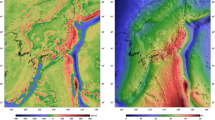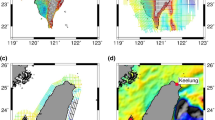Abstract
An adaptive mesh form of the gravity-geologic method, known as improved Gravity-Geologic Method (iGGM), was implemented on free-air gravity anomalies and shipborne depths to obtain an improved 1′ × 1′ bathymetry model of the Gulf of Guinea (15°W–5°E, 4°S–4°N). An optimal density contrast of 8000 kg/m3 was used for the whole area. The iGGM model compared well with NGDC, ETOPO1, and SIO models; with difference standard deviations and correlation coefficients being 180.20 m, 0.9248, 184.34 m, 0.9551, and 179.84 m, 0.8886, respectively. These prove generally that iGGM is efficient for estimating bathymetry with limited shipborne depths. The influence of shipborne depths quantity and optimal density contrast on bathymetry inversion are analysed, respectively, for the whole region and three subregions (15°W–8°W, 4°S–2°N; 7°W–2°E, 2°S–2°N; and 1°E–5°E, 4°S–0°N). Results showed that, compared with the mountainous areas, higher inversion accuracy (standard deviation of test differences less than 50 m) is achievable in the low-lying region using fewer shipborne depths. With 75% of shipborne depths used for the entire model, the standard deviation of differences between iGGM and shipborne depths at test points was 184.74 m. This indicates that to further improve the region’s bathymetry, more ship sounding is required in the mountainous areas. Numerical results showed different optimal densities should be selected for different areas, especially for the mountainous areas. Using a common density contrast in the whole region may limit the accuracy of the bathymetry inversion.










Similar content being viewed by others
References
Bazilian M, Onyeji I, Aqrawi P-K, Sovacool BK, Ofori E, Karmen DM, Van de Graaf T (2013) Oil, energy poverty and resource dependence in West Africa. J Energy Nat Resour Law 31(1):33–53
Becker JJ et al (2009) Global bathymetry and elevation data at 30 arc seconds resolution: SRTM30 PLUS. Mar Geod 32:355–371
Calmant S, Baundry N (1996) Modeling bathymetry by inverting satellite altimetry data: a review. Mar Geophys Res 18(2–4):123–134
Hsiao Y, Kim JW, Kim KB, Lee BY, Hwang C (2011) Bathymetry estimation using the gravity-geologic method: an investigation of density contrast predicted by the downward continuation method. Terr Atmos Ocean Sci 22(3):347–358
Hsiao T-S et al (2016) High-resolution depth and coastline over major atolls of South China Sea from satellite altimetry and imagery. Remote Sens Environ 176:69–83
Hu MZ, Li JC, Li H, Shen CY, Jin TY, Xing LL (2014) Predicting global seafloor topography using multi-source data. Mar Geod. https://doi.org/10.1080/01490419.2014.934415
Hwang C (1999) A bathymetric model for the South China Sea from satellite altimetry and depth data. Mar Geod 22(1):37–51
Ibrahim A, Hinze WJ (1972) Mapping buried bedrock topography with gravity. Ground Water 10(3):18–23
Kim KB, Yun HS (2018) Satellite-derived bathymetry prediction in shallow waters using the gravity-geologic method: a case study in the West Sea of Korea. KSCE J Civ Eng 22(7):2560–2568
Kim KB, Hsiao Y-S, Kim JW, Lee BY, Kwon YK, Kim CH (2010) Bathymetry enhancement by altimetry-derived gravity anomalies in the East Sea (sea of Japan). Mar Geophys Res 31:285–298
Kim JW, von Frese RRB, Lee BY, Roman DR, Doh SJ (2011) Altimetry-derived gravity predictions of bathymetry by gravity-geologic method. Pure Appl Geophys 168:815–826
Osaretin I (2011) Energy security in the Gulf of Guinea and the challenges of the great powers. J Soc Sci 27(3):187–191
Ouyang M, Sun A, Zhai Z (2014) Predicting bathymetry in South China Sea using the gravity-geologic method. Chin J Geophys 57(9):2756–2765
Sandwell DT, Smith WHF (2001) Bathymetry estimation. In: Fu LL, Cazenave A (eds) Satellite altimetry and earth sciences: a handbook of techniques and applications. Academic Press, San Diego, pp 441–457
Sandwell DT, Smith, WHF, Gille S, Jayne S, Soofi K, Coakley B (2001) Bathymetry from Space: White Paper in Support of a High-resolution, Ocean Altimeter Mission. Proceedings of High-resolution Ocean Topography Science Working Group Meeting, CEOAS, April 5
Weszkanys G (2009) The curse of oil in the Gulf of Guinea: a view from Sao Tome and Principe. Afr Aff (Lond) 108(433):679–689
Weszkanys G (2011) Cursed resources, or articulations of economic theory in the Gulf of Guinea. Econ Soc 40(3):345–372
Xiang X, Wan X, Zhang R, Li Y, Sui X, Wang W (2017) Bathymetry inversion with the gravity-geologic method: a study of long-wavelength gravity modeling based on adaptive mesh. Mar Geod 40(5):329–340
Yeu Y, Yee J-J, Yun HS, Kim KB (2018) Evaluation of the accuracy of bathymetry on the Nearshore coastlines of Western Korea from satellite altimetry, multi-beam, and airborne bathymetric LiDAR. Sensors 18(2926). https://doi.org/10.3390/s18092926
Acknowledgments
The authors are grateful to NOAA for providing the ship depth data and DTU for providing the gravity anomaly data. Again, we are thankful to SIO for their model; as well as Natural Earth for providing shapefile and raster data of the globe.
Funding
This work is funded by the National Natural Science Foundation of China (No. 41674026), the Fundamental Research Funds for the Central Universities (No. 2652018027), the Open Research Fund of Key Laboratory of Space Utilization, the Chinese Academy of Sciences(LSU-KFJJ-201902) and Qian Xuesen Lab.—DFH Sat. Co. Joint Research and Development Fund under grants(M-2017-006).
Author information
Authors and Affiliations
Corresponding author
Additional information
Responsible Editor:Hakim Saibi
Rights and permissions
About this article
Cite this article
Annan, R.F., Wan, X. Mapping seafloor topography of gulf of Guinea using an adaptive meshed gravity-geologic method. Arab J Geosci 13, 301 (2020). https://doi.org/10.1007/s12517-020-05297-8
Received:
Accepted:
Published:
DOI: https://doi.org/10.1007/s12517-020-05297-8




